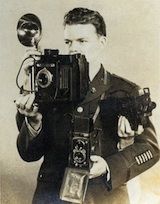- Forum
- General Discussion | Introductions | Off Topic Forum
- Photography General Discussion
- TTL vs Manual mode with flash?
TTL vs Manual mode with flash?
-

- kyclover237
- Lone Wolf
-
- Canon 60D
- Followers: 83
- Posts: 243
-
Points:
0
-

- Henry Peach
- Apprentice
-
- I currently use a 5DII or Sony Nex-3 most of the time.
- Followers: 50
- Posts: 2925
-
Points:
16
Post #110074
-

- lucky1one
- Has the Hang of it
- Canon 1D Mark II
- Followers: 3
- Posts: 74
-
Points:
0
Post #110082
If your subject is static, then setting the flash exposure manually is fine. You have plenty of time to change the power setting.
It is important to clarify what we are talking about here is using manual or automatic FLASH exposure. E-TTL is letting the camera set the flash power level automatically. Using manual exposure involves the user setting the power level on the back of the flash unit.
Post #110086
lucky1one wrote: E-TTL is most effectively used in situations where the distance between the subject and the speedlite changes constantly. For example, you are shooting pictures of players in a basketball game. Because the players are moving toward and away from your speedlite, the the power level of your flash needs to change accordingly. E-TTL is a good choice, because it can do a quicker job than you could manually. This could be useful tool when shooting a wedding.
If your subject is static, then setting the flash exposure manually is fine. You have plenty of time to change the power setting.
First off, thank you all for your answers.
Now considering what you have said, even with a static subject what reason would there be to shoot in manual flash? If E-TTL does all the leg work, static or not, why would you use manual flash?
My Passion is being behind my camera and my family.
-

- MLKstudios
- Banned
-
- D800 ;-)
- Followers: 72
- Posts: 4480
-
Points:
2
Post #110095
As lucky pointed out, TTL compensates for distance AND aperture changes.
Matthew
Matthew L Kees
MLK Studios Photography School
www.MLKstudios.com
[email protected]
"Every artist, was once an amateur"
-

- Henry Peach
- Apprentice
-
- I currently use a 5DII or Sony Nex-3 most of the time.
- Followers: 50
- Posts: 2925
-
Points:
16
Post #110100
Casey T wrote: Now considering what you have said, even with a static subject what reason would there be to shoot in manual flash? If E-TTL does all the leg work, static or not, why would you use manual flash?
The ETTL is run by a reflective light meter, which is easily fooled by changes in tone even if the light does not change. For instance when I switch from a bride in all white to a groom in mostly black. If I've set the flash power manually it'll keep giving me the same exposure, so I can just keep shooting. If I'm using ETTL I have to take some test shots to figure out how much lighter or darker to tell the camera to compensate for.
-

- lucky1one
- Has the Hang of it
- Canon 1D Mark II
- Followers: 3
- Posts: 74
-
Points:
0
Post #110221
There are situations when you want to switch to manual:
a. your subject may blink at the preflash when you use TTL. As a result, the subject's eyes are closed when you fire off the shutter. One way to get around this is to manually fire off the preflash by pushing the FEL button and let the person blink first. Then you fire off the shutter after a brief moment.
b. another potential problem could occur when you try to trigger non-Canon flashes with optical slaves. These non-Canon flashes may be fooled by the preflash and trigger prematurely. This is the reason you need to switch to manual.
c. when you set your camera to aperture priority and TTL mode, your camera automatically sets the shutter speed. What happens when you shoot in low light conditions is that the camera will often set an excessively long shutter speed. As a result, the background (ambient light) is overexposed. If you want greater control of the ambient light exposure, then you need to switch to manual.
-

- Henry Peach
- Apprentice
-
- I currently use a 5DII or Sony Nex-3 most of the time.
- Followers: 50
- Posts: 2925
-
Points:
16
Post #110225
lucky1one wrote: c. when you set your camera to aperture priority and TTL mode, your camera automatically sets the shutter speed. What happens when you shoot in low light conditions is that the camera will often set an excessively high shutter speed. As a result, the background (ambient light) is overexposed. If you want greater control of the ambient light exposure, then you need to switch to manual.
I think you mean low.
-

- lucky1one
- Has the Hang of it
- Canon 1D Mark II
- Followers: 3
- Posts: 74
-
Points:
0
-

- Henry Peach
- Apprentice
-
- I currently use a 5DII or Sony Nex-3 most of the time.
- Followers: 50
- Posts: 2925
-
Points:
16
Post #110238
lucky1one wrote: yes, you're right. I mean excessively LONG shutter speed. Thanks for the correction, HP.
I do the same thing all the time.
-
 Pt+
Pt+ - Alex
- PT Founder
-
- Canon EOS R5 | EOS R | M6 II
- Followers: 1795
- Posts: 4785
-
Points:
48943
Post #110396
Henry Peach wrote:
lucky1one wrote: yes, you're right. I mean excessively LONG shutter speed. Thanks for the correction, HP.
I do the same thing all the time.My brain knows what I mean, but my fingers type it backwards.
Happens to me too!
Thank you for making PhotographyTalk.com your photography community of choice.
- Forum
- General Discussion | Introductions | Off Topic Forum
- Photography General Discussion
- TTL vs Manual mode with flash?
Latest Reviews
The Olympus Pen E-P7 is an affordable micro four thirds mirrorless camera with 4K video capabilities, a 20.3MP sensor, and 121 focus points, making it a solid entry-level camera for beginners.
The Panasonic G9 II is a 25.2-megapixel micro four thirds camera with numerous features that make it punch out of its weight class, like 779 AF points, 5.8K video, and weather sealing.
The Fujifilm XT5 is a 40MP mirrorless camera capable of 6.2K video at 30p. With those specs, it’s an ideal choice for photographers needing a camera to pull double duty for imaging and video.
The Canon EOS R100 is an entry-level mirrorless camera introduced in 2023. But just because it’s an entry-level camera doesn’t mean it’s a bare-bones camera. Find out why in this review!
Forum Top Posters
-
1Scotty 8 posts
-
2TCav 6 posts
-
3Ruby Grace 6 posts
-
4Nefarious 3 posts
-
5CharleyL 3 posts
-
6Roger Lang 3 posts
-
7ShutterPal 3 posts
-
8James L 2 posts
-
9Clark Guay 2 posts
-
10Petroguy 2 posts
Latest Articles
The best photography jobs right now are a mix of tried-and-true gigs like wedding photography and new jobs highlighting AI’s capabilities, travel, and videography.
The Olympus Pen E-P7 is an affordable micro four thirds mirrorless camera with 4K video capabilities, a 20.3MP sensor, and 121 focus points, making it a solid entry-level camera for beginners.
Starting a photography business is one thing; sustaining your business over a long period of time is another. Use the tips in this professional photography guide to build something with longevity!
The Panasonic G9 II is a 25.2-megapixel micro four thirds camera with numerous features that make it punch out of its weight class, like 779 AF points, 5.8K video, and weather sealing.
Cinematic photography is an interesting genre that combines photographic and videographic skills along with effective storytelling techniques. The result? Highly impactful images!
Newborn photography requires skill, the right gear, and a lot of patience. This beginner’s guide discusses critical topics that will help you be more prepared for before, during, and after the shoot.
To fill the frame means to expand the footprint of the subject in your shot. Get in close, zoom in, crop the image, or use other techniques to bring the subject to the forefront.
With these simple yet effective beginner photography tips, you can avoid some of the common mistakes beginners make and get improved results with your images.














